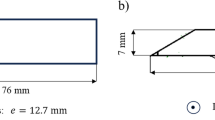Abstract
Machining of critical components such as turbine compressor and pump parts is required to generate compressive residual stress on the surface layer in order to obtain high fatigue life. As an effective method to generate and improve the compressive residual stress of machined parts, burnishing has been widely used in industry. Despite its importance, few studies have investigated the mechanism of burnishing on surface residual stress. In this paper, the interference effects due to nearby burnishing points were revealed and investigated in the context of an elastic burnishing tool. The interference effects during the burnishing process help to enhance the compressive residual stress and improve the distribution of compressive residual stress on the burnished surface layer. In order to analyze the mechanism behind the interference effect more clearly, a 2D finite element model of the burnishing process was developed. It was found that the interference effect exists and becomes stronger as the feed rate is decreased. Small feed rates show a more apparent effect on the enhancement of interference effects. The results indicate that the interference effect of the workpiece surface is mainly created by the influence of the preceding burnishing points on the future burnished surface.
Similar content being viewed by others
References
Bouzid W, Tsoumarev O, Saï K (2004) An investigation of surface roughness of burnished AISI 1042 steel. Int J Adv Manuf Technol 24:120–125
Li FL, Xia W, Zhou ZY, Zhao J, Tang ZQ (2012) Analytical prediction and experimental verification of surface roughness during the burnishing process. Int J Mach Tools Manuf 62:67–75
Revankar GD, Shetty R, Rao SS, Gaitonde VN (2014) Analysis of surface roughness and hardness in ball burnishing of titanium alloy. Measurement 58:256–268
Rao DS, Hebbar HS, Komaraiah M (2007) Surface hardening of high-strength low alloy steels (HSLA) dual-phase steels by ball burnishing using factorial design. Mater Manuf Process 22:825–829
Maawad E, Brokmeier HG, Wagner L, Sano Y, Genzel C (2011) Investigation on the surface and near-surface characteristics of Ti–2.5Cu after various mechanical surface treatments. Surf Coat Technol 205:3644–3650
Lacalle LNLD, Lamikiz A, Sánchez JA, Arana JL (2007) The effect of ball burnishing on heat-treated steel and Inconel 718 milled surfaces. Int J Adv Manuf Technol 32:958–968
Sasahara H (2005) The effect on fatigue life of residual stress and surface hardness resulting from different cutting conditions of 0.45%C steel. Int J Mach Tools Manuf 45:131–136
Moussaoui K, Mousseigne M, Senatore J, Chieragatti R (2015) The effect of roughness and residual stresses on fatigue life time of an alloy of titanium. Int J Adv Manuf Technol 78:557–563
Webster GA, Ezeilo AN (2001) Residual stress distributions and their influence on fatigue lifetimes. Int J Fatigue 23:375–383
Abrão AM, Denkena B, Köhler J, Breidenstein B, Mörke T (2015) The inducement of residual stress through deep rolling of AISI 1060 steel and its subsequent relaxation under cyclic loading. Int J Adv Manuf Technol 79:1939–1947
Sartkulvanich P, Altan T, Jasso F, Rodriguez C (2007) Finite element modeling of hard roller burnishing: an analysis on the effects of process parameters upon surface finish and residual stresses. J Manuf Sci Eng 129:705–716
Rodríguez A, Lacalle LNLD, Celaya A, Lamikiz A, Albizuri J (2012) Surface improvement of shafts by the deep ball-burnishing technique. Surf Coat Tech 206:2817–2824
Gharbi F, Sghaier S, Hamdi H, Benameur T (2012) Ductility improvement of aluminum 1050A rolled sheet by a newly designed ball burnishing tool device. Int J Adv Manuf Technol 60:87–99
Chomienne V, Valiorgue F, Rech J, Verdu C (2016) Influence of ball burnishing on residual stress profile of a 15-5PH stainless steel. CIRP J Manuf Sci Technol 13:90–96
Avilés R, Albizuri J, Rodríguez A, Lacalle LNLD (2013) Influence of low-plasticity ball burnishing on the high-cycle fatigue strength of medium carbon AISI 1045 steel. Int J Fatigue 55:230–244
Sayahi M, Sghaier S, Belhadjsalah H (2013) Finite element analysis of ball burnishing process: comparisons between numerical results and experiments. Int J Adv Manuf Technol 67:1665–1673
Deng WJ, Xia W, Zhou ZY, Chen WP, Li YY (2004) Finite element analysis of effects of ball burnishing parameters on residual stresses. Mater Sci Forum 471-472:658–662
Saï WB, Saï K (2005) Finite element modeling of burnishing of AISI 1042 steel. Int J Adv Manuf Technol 25:460–465
Röttger K (2003) Walzen hartgedrehter Oberflächen. Dissertation, RWTH Aachen, Shaker Verlag, Aachen
El-Axir MH, El-Khabeery MM (2003) Influence of orthogonal burnishing parameters on surface characteristics for various materials. J Mater Process Technol 132:82–89
Valdivielso AF, Lacalle LNLD, Urbikain G, Rodriguez A (2016) Detecting the key geometrical features and grades of carbide inserts for the turning of nickel-based alloys concerning surface integrity. Proc IMechE Part C: J Mech Eng Sci 230(20):3725–3742
Acknowledgements
This research was conducted under the support of the National Natural Science Foundation of China (51375174), Fundamental Research Funds for the Central Universities (2015PT013), Guangdong Natural Science Funds for Distinguished Young Scholar (S2013050014163).
Author information
Authors and Affiliations
Corresponding author
Ethics declarations
This research did not involve any human participants or animals.
Conflict of interest
The authors declare that they have no conflict of interest.
Rights and permissions
About this article
Cite this article
He, D., Wang, B., Zhang, J. et al. Investigation of interference effects on the burnishing process. Int J Adv Manuf Technol 95, 1–10 (2018). https://doi.org/10.1007/s00170-017-0640-3
Received:
Accepted:
Published:
Issue Date:
DOI: https://doi.org/10.1007/s00170-017-0640-3




